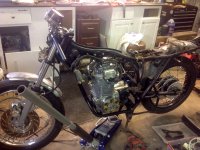Once again, a subject that seems to be more complicated than it actually is. You can split it up into two sections: (1) the point gap, and (2) the "timing" or the point in crankshaft rotation that the spark plug fires. While the two things are interconnected, it is only a manifestation of the mechanism, they actually are independent in what they do.
The first thing to do is realize that the points are merely a switch. A simple on/off switch. They connect and disconnect electrical current flow to the ignition coil. The coil is a simple electrical transformer which works by taking the 12 volts (often reduced to less, but keeping the concept simple here) from your bikes electrical system and passing it through a bunch of circular windings, hence the name "coil". When you do this, a magnetic field is created within the windings. If you place another coil within the first coil, the magnetic field will induce a voltage into that coil, even though it is not connected electrically to the first. If the second coil has 10 times the count of windings of the first, it will have 10 times the voltage. This is the portion of the coil connected to your spark plug.
Not much happens if you simply connect 12 volts to your coil. The magnetic field builds rather slowly. But suddenly disconnect it, and the suddenly collapsing magnetic field in the primary (12 volt) windings induces a very sharp voltage in the secondary windings and the spark plug fires.
This is the main thing to understand about the points: They are connected to the negative post on the ignition coil and they cause the coil to fire the plug when they open and break the complete circuit to the coil.
The break in the circuit must be swift because the voltage for the plug depends on the rate at which the magnetic flux changes within the coil. If it is too slow due to arcing across the point faces, the magnetic field collapse will not be fast enough to create enough voltage to bridge the gap at the spark plug. So we add a capacitor to the negative side of to coil to reduce the arcing at the points and make the break in the circuit more abrupt and complete. The capacitor is usually located next to the points, and is called a condenser just to make things senselessly confusing. Some systems will actually run without the condenser, but not for long as the points erode very quickly with all the arcing.
So the first thing to do is make sure the switch contacts are clean and sound mechanically. The point faces should be clean and flat and shiny. The faces should be perfectly flat and parallel to each other, and not misaligned. You can clean up old points with a file and fine sandpaper finishing with clean white piece of card stock like a business card. Often even brand new points need a bit of tweaking to get the contacts into good alignment which can be done with some super careful bending with some needle nose pliers. Once the contacts are perfected, it is time to adjust the gap.
The point gap is often referred to as the "dwell angle". This refers to the dwell, or length of time the points are closed in relationship to crankshaft degrees. This is important because the coil needs a certain amount of time to build the magnetic field and also time to cool off before the next cycle. The points also need to separate at least a certain amount to help with a clean break and minimize arcing.
You set the point gap first because it is independent of timing. Rotate the engine around until the points cam has the points you are working on open to their widest point. Crack the hold down screws loose, and adjust the base plate back and forth until the gap between the point faces is to spec, .014" for most bikes. Note that each set of points has its own little base plate mounted on a larger base plate that can also be adjusted independently. The larger base plate is to adjust the timing. You can see that adjusting the points gap moves the assembly closer or farther from the cam, but adjusting the timing plate merely rotates the whole shootin' match around the cam. So adjusting the timing will not affect the gap. However, adjusting the gap will affect the timing, so get that done first. It is very easy to do, but very important to do right. Too much gap, and the coil is not energized for long. Too small a gap and maybe it is energized for too long and does not get enough time to cool between cycles.
Once you get both sets of points adjusted, make sure they are clean and start the bike. Connect a strobe light and set the timing according to the manual. Usually there are marks on the generator rotor. Adjust the timing plate so the appropriate marks align. Usually there is another mark for maximum advance, and when you rev up the engine, you should see those marks come into alignment and then realign with the first set once back down to idle.
Breaker point systems have a lot going for them. They are easy to understand, and super simple to maintain and troubleshoot. They are cheap, very reliable, and most importantly can usually be made to work on the side of the road! However, they do require maintenance as the point faces degrade and the rubbing block wears. But can expect a couple thousand miles at a crack of very good performance if you adjust them properly to begin with.





